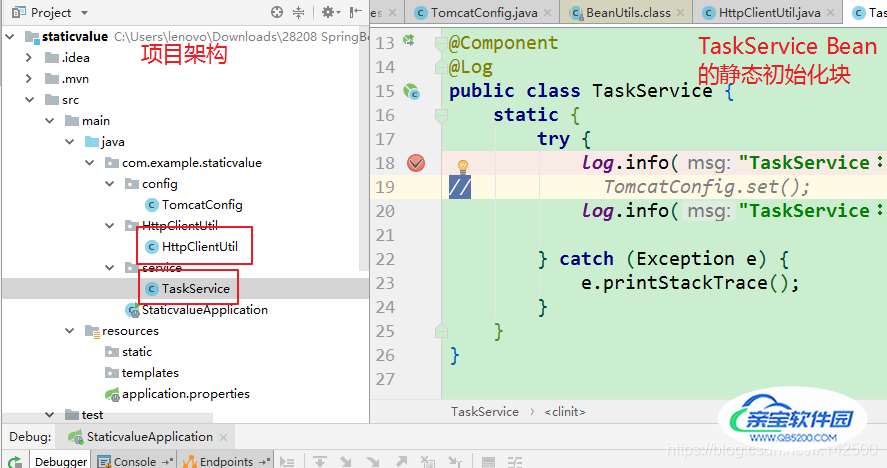使用@Value为静态变量导入并使用导入的静态变量进行初始化方式
思影影思 人气:01 问题描述
在南京出差时,在开始开发,自己把一些相对紧密联系的不变得配置放进一个类中,这些字段为static的,待交付时,由于这些配置也要是可以通过配置文件进行配置的,因此无形之中就引入了一个问题。
即使用@Value对静态变量进行导入的问题。并且还有一种更加复杂的情形,即需要在生成相关的Bean时,需要进行一些资源的初始化,在当时自己结结实实的踩了一把坑。
在项目开始时TomcatConfig类是如下的:
public class TomcatConfig {
public static String ip = "192.168.1.112";
public static int port=8080;
public static String username=admin;
public static String password=admin;
}
但在交付之前,要把这些配置值放入配置文件,例如application.properties
tomcat.ip=10.30.102.111 tomcat.port=8080 tomcat.username=admin tomcat.password=admin
并且要在该类再开始时通过HTTP调用,使用这些参数进行一次初始化。
2 问题结构
2.1 服务方
可以理解自己开发的模块依赖于其他的模块,模块之间通过HTTP通信获取数据和状态。可以通过Spring Boot起一个程序提供一个对外的接口,即相当于提供服务。
这就是服务提供的类。
该程序所在的服务器ip和端口即上边已经写进配置文件的ip和端口。
package com.wisely.ch6_2_3.controller;
import com.alibaba.fastjson.JSON;
import com.alibaba.fastjson.JSONObject;
import com.wisely.ch6_2_3.config.TomcatSetting;
import lombok.extern.java.Log;
import org.springframework.beans.factory.annotation.Autowired;
import org.springframework.http.MediaType;
import org.springframework.web.bind.annotation.RequestMapping;
import org.springframework.web.bind.annotation.RequestParam;
import org.springframework.web.bind.annotation.RestController;
import java.util.UUID;
/**
* 测试注入
*
* @Owner:
* @Time: 2019/3/31-16:29
*/
@RestController
@Log
public class TestValue {
@Autowired
private TomcatSetting serverConfig;
@RequestMapping(value = "/getImg",produces = MediaType.APPLICATION_JSON_UTF8_VALUE)
public String getImgeLoc() {
log.info("Enter getImgeLoc");
System.out.println("-- Handling --");
String fileName = UUID.randomUUID().toString()+".jpg";
JSONObject result = new JSONObject();
result.put("imgUrl", serverConfig.getUrl()+"/"+fileName);
System.out.println("-- over --");
return result.toJSONString();
}
@RequestMapping("/getmapping")
public String service(@RequestParam("username") String username, @RequestParam("password") String password) {
if (!username.equals("admin") ||!password.equals("admin")) {
JSONObject res = new JSONObject();
res.put("state", -1);
res.put("msg", "fail");
return res.toJSONString();
}
JSONObject result = new JSONObject();
result.put("state", 0);
result.put("msg", "success");
JSONObject data = new JSONObject();
data.put("aaa", "bbb");
data.put("ccc", "ddd");
result.put("data", data);
return result.toJSONString();
}
}
2.2 客户方
由于之前写的代码是硬编码,肯定要重构这部分的代码,@Value可以灵活的实现注入,但通过在互联网上查询相关的页面可以得到如下的知识:
- SpringBoot中使用@Value()只能给普通变量注入值,不能直接给静态变量赋值,并且@Value使用设值函数为成员注入值。
- 为了给静态变量注入值,需要使用特殊的语法
2.2.1核心类 TomcatConfig
package com.example.staticvalue.config;
import com.alibaba.fastjson.JSONObject;
import com.example.staticvalue.HttpClientUtil.HttpClientUtil;
import com.fasterxml.jackson.databind.util.JSONPObject;
import lombok.Getter;
import lombok.extern.java.Log;
import org.apache.http.protocol.HTTP;
import org.springframework.beans.factory.annotation.Value;
import org.springframework.boot.context.properties.ConfigurationProperties;
import org.springframework.context.annotation.ComponentScan;
import org.springframework.stereotype.Component;
import java.util.HashMap;
import java.util.Map;
/**
* tomcat配置
*
* @Owner:
* @Time: 2019/3/31-19:25
*/
@Component
@Log
public class TomcatConfig {
@Getter
private static String ip;
@Getter
private static int port;
@Getter
private static String username;
@Getter
private static String password;
private static JSONObject data = new JSONObject();
# 在静态初始化块中调用set()是无效的,因为此时ip等变量尚未注入。应该是在该Bean已经生成了,即ip,port,usernam,password已经注入之后再调用set()这样才有效。
static {
log.info("静态化块");
log.info("TomcatConfig.ip: "+ TomcatConfig.ip);
~~~~try {
~~set();~~
~~} catch (Exception e) {~~
~~e.printStackTrace();~~
}~~~~
}
@Value("${tomcat.ip}")
public void setIp(String ip) {
TomcatConfig.ip = ip;
}
@Value("${tomcat.password}")
public void setPassword(String password) {
TomcatConfig.password = password;
}
@Value("${tomcat.port}")
public void setPort(int port) {
TomcatConfig.port = port;
}
@Value("${tomcat.username}")
public void setUsername(String username) {
TomcatConfig.username = username;
}
// 注意该函数应在类外进行调用,比如set()可以放置在其他标注了雷瑟@Componet的Bean类中,这样可以保证在TomcatConfig的bean已经生成。
public static void set() throws Exception {
log.info("Enter set");
log.info("TomcatConfig.ip: "+ TomcatConfig.ip);
String accessUrl = "http://"+getIp()+":"+getPort()+"/getmapping?";
accessUrl += "username="+username+"&"+"password="+password;
log.info("accessUrl = "+accessUrl);
String result = HttpClientUtil.postJson(accessUrl, "{}");
JSONObject ret = JSONObject.parseObject(result);
if (ret.getIntValue("state") == 0) {
data = ret.getJSONObject("data");
}
}
}
注意:set()方法完成了类似初始化的工作,即通过调用一次http请求,填充了static成员data的值。
set()的调用不可以放在本类的静态环境下,尤其在war包运行在tomcat之下更是这样,在jar包中set()函数的调用放在静态函数main之中是有效的。
这可以通过日志进行证明,如果是war包跑在tomcat环境下,若为如下代码:
public static void main(String[] args) throws Exception{
log.info("Enter main");
SpringApplication.run(StaticvalueApplication.class, args);
log.info("after run");
TomcatConfig.set();
log.info("after set");
}
程序会仅执行到after run日志打印,不会执行TomcatConfig.set()的调用,切记,切记
如果真的是在war包跑在tomcat下,可以使用如下的方式解决,可以把TomcatConfig.set()的调用放在其他Bean类的静态初始化块中。
2.2.2 项目结构

2.2.3辅助类HttpClientUtil
package com.example.staticvalue.HttpClientUtil;
import org.apache.http.HttpEntity;
import org.apache.http.client.ClientProtocolException;
import org.apache.http.client.methods.CloseableHttpResponse;
import org.apache.http.client.methods.HttpPost;
import org.apache.http.entity.ByteArrayEntity;
import org.apache.http.impl.client.CloseableHttpClient;
import org.apache.http.impl.client.HttpClients;
import org.apache.http.util.CharArrayBuffer;
import org.apache.http.util.EntityUtils;
import java.io.IOException;
import java.io.InputStreamReader;
import java.io.UnsupportedEncodingException;
/**
* 辅助类,使用http获取数据
*
* @Owner:
* @Time: 2019/3/31-19:49
*/
public class HttpClientUtil {
public static String postJson(String url,String jsonString) throws Exception
{
String result = null;
CloseableHttpClient httpClient = HttpClients.createDefault();
HttpPost post = new HttpPost(url);
CloseableHttpResponse response = null;
try {
post.setEntity(new ByteArrayEntity(jsonString.getBytes("UTF-8")));
post.setHeader("Content-Type","application/json" );
response = httpClient.execute(post);
if(response != null && response.getStatusLine().getStatusCode() == 200)
{
HttpEntity entity = response.getEntity();
result = entityToString(entity);
}
return result;
} catch (UnsupportedEncodingException e) {
e.printStackTrace();
} catch (ClientProtocolException e) {
e.printStackTrace();
} catch (IOException e) {
e.printStackTrace();
}finally {
try {
httpClient.close();
if(response != null)
{
response.close();
}
} catch (IOException e) {
e.printStackTrace();
}
}
return null;
}
private static String entityToString(HttpEntity entity) throws IOException {
String result = null;
if(entity != null)
{
long lenth = entity.getContentLength();
if(lenth != -1 && lenth < 2048)
{
result = EntityUtils.toString(entity,"UTF-8");
}else {
InputStreamReader reader1 = new InputStreamReader(entity.getContent(), "UTF-8");
CharArrayBuffer buffer = new CharArrayBuffer(2048);
char[] tmp = new char[1024];
int l;
while((l = reader1.read(tmp)) != -1) {
buffer.append(tmp, 0, l);
}
result = buffer.toString();
}
}
return result;
}
}
2.2.4 启动类
package com.example.staticvalue;
import com.example.staticvalue.config.TomcatConfig;
import lombok.extern.java.Log;
import org.springframework.boot.SpringApplication;
import org.springframework.boot.autoconfigure.SpringBootApplication;
@SpringBootApplication
@Log
public class StaticvalueApplication {
public static void main(String[] args) throws Exception{
log.info("Enter main");
SpringApplication.run(StaticvalueApplication.class, args);
log.info("after run");
//在Jar包中运行时,下句是可以生效的,但在war包运行在tomcat中时,TomcatConfig。set()以及之后的语句不会执行。把Tomcat.set()放在某个Bean的静态初始化块中即可
TomcatConfig.set();
log.info("after set");
}
}
2.2.5 TaskService
package com.example.staticvalue.service;
import com.example.staticvalue.config.TomcatConfig;
import lombok.extern.java.Log;
import org.springframework.stereotype.Component;
/**
* 任务类
*
* @Owner:
* @Time: 2019/3/31-19:39
*/
@Component
@Log
public class TaskService {
static {
try {
log.info("TaskService: before set");
TomcatConfig.set();
log.info("TaskService: after set");
} catch (Exception e) {
e.printStackTrace();
}
}
}
3总结
上述注入静态变量的主要原因是静态变量因为一些遗留的原因,为了解决硬编码的问题而引入的,至于在静态变量通过@Value注入时同时在该类中进行初始化,则是非常不优雅的一种编程风格,这种初始化的方式更加建议放置在类似开机自启动的应用程序中,在Spring Boot中也确实有这样的实现场景。
即CommandLineRunner接口,实现该接口的类必须实现run()方法,而该方法会在所有Bean均已正确生成之后开始执行。
关于CommandLineRunner,可以参考CommandLineRunner或者ApplicationRunner接口,至于这种用法,改天再来写一篇阐述的文章吧。
总结
以上为个人经验,希望能给大家一个参考,也希望大家多多支持。
加载全部内容